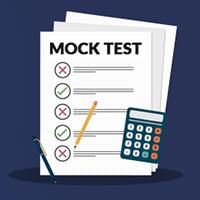CLAT Exam > CLAT Questions > What are mock tests for the CLAT exam?
Start Learning for Free
What are mock tests for the CLAT exam?
Most Upvoted Answer
What are mock tests for the CLAT exam?
Mock Tests for the CLAT Exam
Mock tests play a crucial role in the preparation for the Common Law Admission Test (CLAT). They are designed to simulate the actual exam environment and provide candidates with an opportunity to assess their preparation level. Mock tests help in identifying strengths and weaknesses, improving time management skills, and gaining familiarity with the exam pattern and question types. Let's delve into the details of mock tests for the CLAT exam.
Benefits of Taking Mock Tests
1. Assessment of Preparation Level: Mock tests enable candidates to evaluate their current preparation level. They give candidates an idea of how well they have understood the concepts and how effectively they can apply them in a timed exam scenario.
2. Time Management Skills: CLAT is a time-bound exam, and practicing mock tests helps candidates learn to manage their time efficiently. By solving questions within the given time frame, candidates can improve their speed and accuracy, which are crucial for scoring well.
3. Familiarity with Exam Pattern: Mock tests are based on the actual CLAT exam pattern. By solving these tests, candidates become familiar with the types of questions asked, the marking scheme, and the overall structure of the exam. This familiarity helps reduce anxiety and boosts confidence on the actual exam day.
4. Identification of Weak Areas: Through mock tests, candidates can identify their weak areas and focus on improving them. Analyzing the test results and understanding the areas where they made mistakes or faced difficulty helps candidates strategize their preparation effectively.
5. Revision and Practice: Mock tests provide an opportunity for revision and practice. By attempting a wide range of questions and solving papers from previous years, candidates can reinforce their knowledge, strengthen their concepts, and enhance their problem-solving abilities.
How to Use Mock Tests Effectively
1. Regular Practice: Candidates should regularly practice mock tests to maintain consistency in their preparation. Allocating a specific time for solving mock tests can help in creating a disciplined study routine.
2. Timed Practice: Candidates should strictly adhere to the time limits while attempting mock tests. This helps in improving speed and accuracy, which are essential for the CLAT exam.
3. Review and Analysis: After completing each mock test, candidates should thoroughly analyze their performance. This includes identifying mistakes, understanding the correct solutions, and revisiting the concepts related to the questions they answered incorrectly.
4. Simulate Exam Environment: Candidates should create an exam-like environment while taking mock tests. This includes sitting in a quiet room, avoiding distractions, and using a timer to simulate the actual exam conditions.
5. Track Progress: Candidates should keep track of their mock test scores and monitor their progress over time. This helps in identifying improvement areas and measuring the effectiveness of their preparation strategies.
In conclusion, mock tests are an invaluable tool for CLAT exam preparation. They provide candidates with a platform to assess their preparation level, improve time management skills, and gain familiarity with the exam pattern. By using mock tests effectively, candidates can enhance their performance and increase their chances of success in the CLAT exam.
Mock tests play a crucial role in the preparation for the Common Law Admission Test (CLAT). They are designed to simulate the actual exam environment and provide candidates with an opportunity to assess their preparation level. Mock tests help in identifying strengths and weaknesses, improving time management skills, and gaining familiarity with the exam pattern and question types. Let's delve into the details of mock tests for the CLAT exam.
Benefits of Taking Mock Tests
1. Assessment of Preparation Level: Mock tests enable candidates to evaluate their current preparation level. They give candidates an idea of how well they have understood the concepts and how effectively they can apply them in a timed exam scenario.
2. Time Management Skills: CLAT is a time-bound exam, and practicing mock tests helps candidates learn to manage their time efficiently. By solving questions within the given time frame, candidates can improve their speed and accuracy, which are crucial for scoring well.
3. Familiarity with Exam Pattern: Mock tests are based on the actual CLAT exam pattern. By solving these tests, candidates become familiar with the types of questions asked, the marking scheme, and the overall structure of the exam. This familiarity helps reduce anxiety and boosts confidence on the actual exam day.
4. Identification of Weak Areas: Through mock tests, candidates can identify their weak areas and focus on improving them. Analyzing the test results and understanding the areas where they made mistakes or faced difficulty helps candidates strategize their preparation effectively.
5. Revision and Practice: Mock tests provide an opportunity for revision and practice. By attempting a wide range of questions and solving papers from previous years, candidates can reinforce their knowledge, strengthen their concepts, and enhance their problem-solving abilities.
How to Use Mock Tests Effectively
1. Regular Practice: Candidates should regularly practice mock tests to maintain consistency in their preparation. Allocating a specific time for solving mock tests can help in creating a disciplined study routine.
2. Timed Practice: Candidates should strictly adhere to the time limits while attempting mock tests. This helps in improving speed and accuracy, which are essential for the CLAT exam.
3. Review and Analysis: After completing each mock test, candidates should thoroughly analyze their performance. This includes identifying mistakes, understanding the correct solutions, and revisiting the concepts related to the questions they answered incorrectly.
4. Simulate Exam Environment: Candidates should create an exam-like environment while taking mock tests. This includes sitting in a quiet room, avoiding distractions, and using a timer to simulate the actual exam conditions.
5. Track Progress: Candidates should keep track of their mock test scores and monitor their progress over time. This helps in identifying improvement areas and measuring the effectiveness of their preparation strategies.
In conclusion, mock tests are an invaluable tool for CLAT exam preparation. They provide candidates with a platform to assess their preparation level, improve time management skills, and gain familiarity with the exam pattern. By using mock tests effectively, candidates can enhance their performance and increase their chances of success in the CLAT exam.

|
Explore Courses for CLAT exam
|

|
Similar CLAT Doubts
Question Description
What are mock tests for the CLAT exam? for CLAT 2025 is part of CLAT preparation. The Question and answers have been prepared according to the CLAT exam syllabus. Information about What are mock tests for the CLAT exam? covers all topics & solutions for CLAT 2025 Exam. Find important definitions, questions, meanings, examples, exercises and tests below for What are mock tests for the CLAT exam?.
What are mock tests for the CLAT exam? for CLAT 2025 is part of CLAT preparation. The Question and answers have been prepared according to the CLAT exam syllabus. Information about What are mock tests for the CLAT exam? covers all topics & solutions for CLAT 2025 Exam. Find important definitions, questions, meanings, examples, exercises and tests below for What are mock tests for the CLAT exam?.
Solutions for What are mock tests for the CLAT exam? in English & in Hindi are available as part of our courses for CLAT.
Download more important topics, notes, lectures and mock test series for CLAT Exam by signing up for free.
Here you can find the meaning of What are mock tests for the CLAT exam? defined & explained in the simplest way possible. Besides giving the explanation of
What are mock tests for the CLAT exam?, a detailed solution for What are mock tests for the CLAT exam? has been provided alongside types of What are mock tests for the CLAT exam? theory, EduRev gives you an
ample number of questions to practice What are mock tests for the CLAT exam? tests, examples and also practice CLAT tests.

|
Explore Courses for CLAT exam
|

|
Signup to solve all Doubts
Signup to see your scores go up within 7 days! Learn & Practice with 1000+ FREE Notes, Videos & Tests.





























